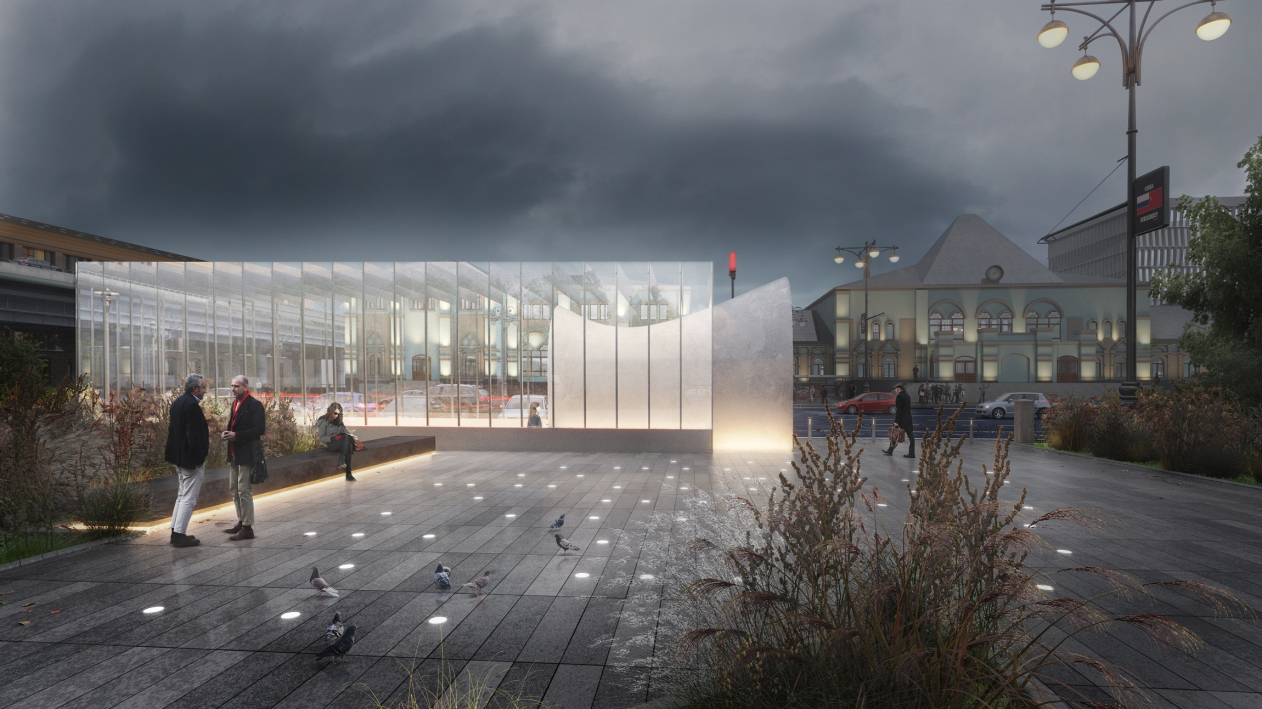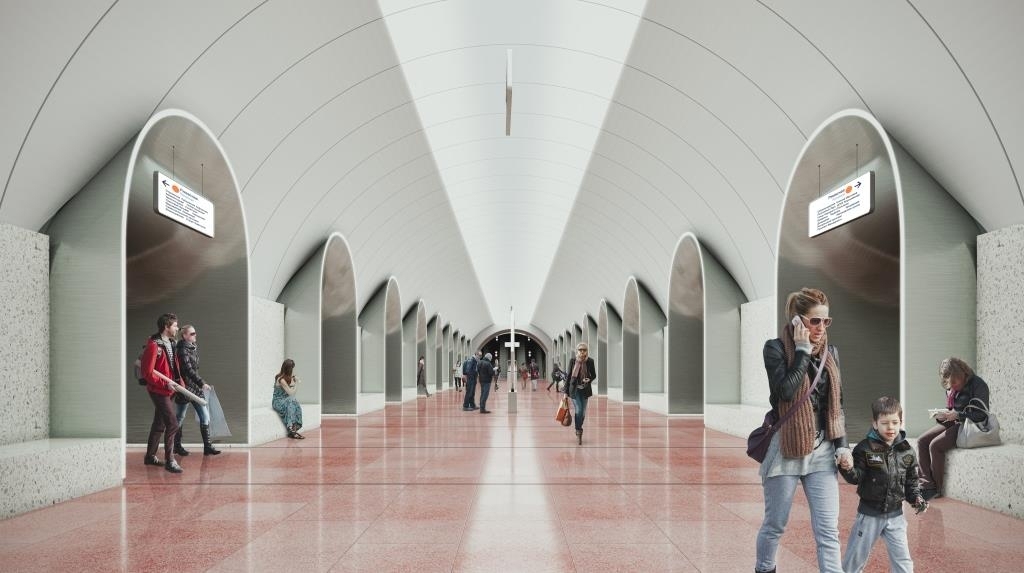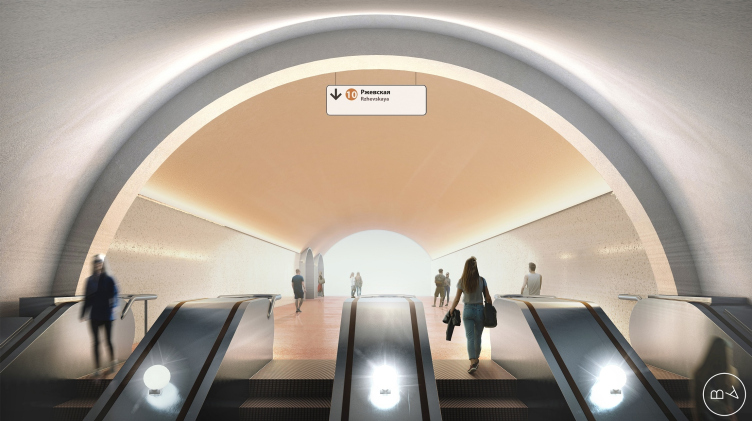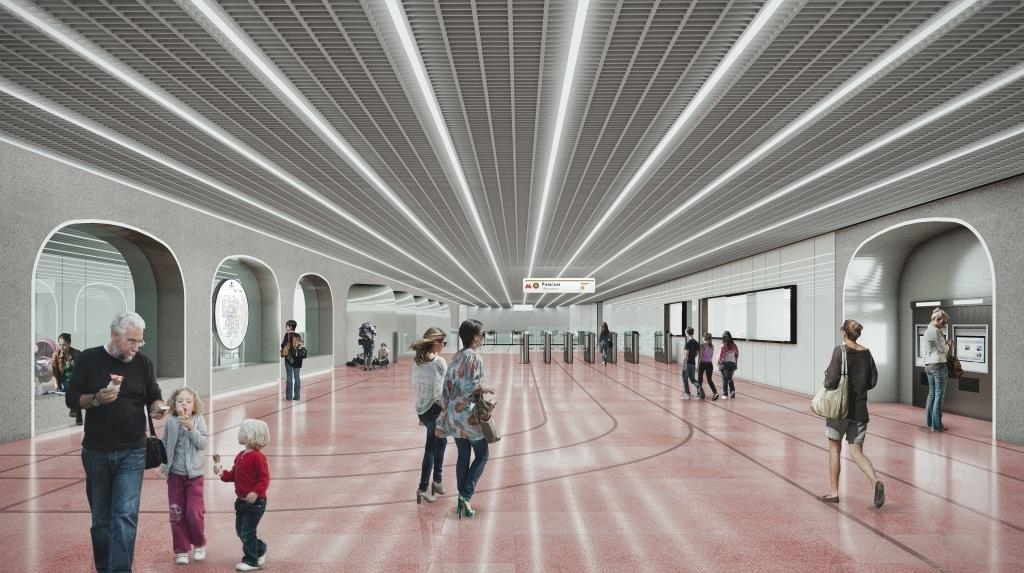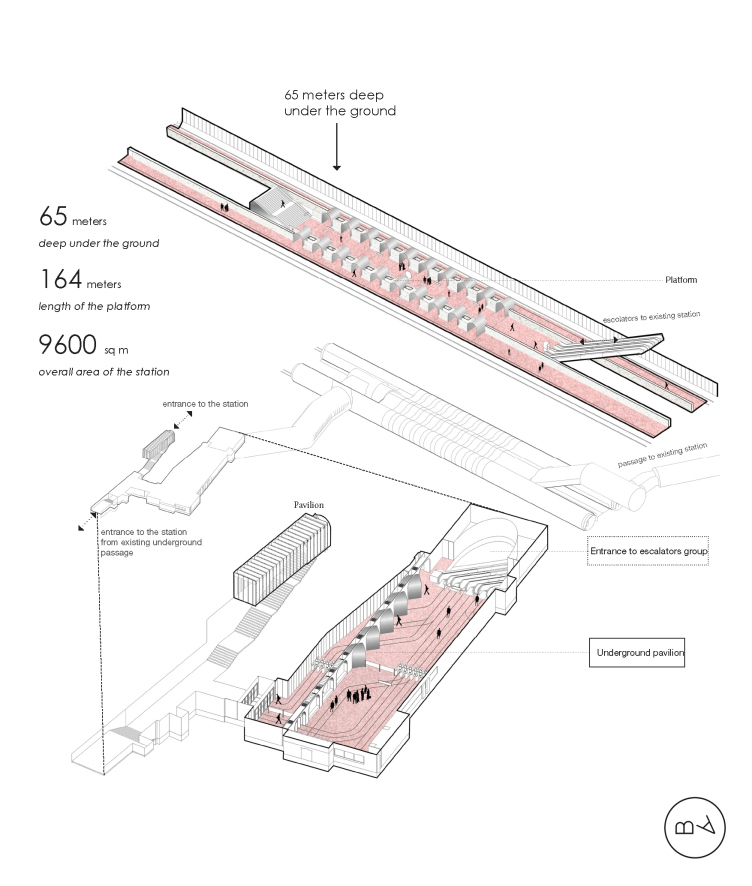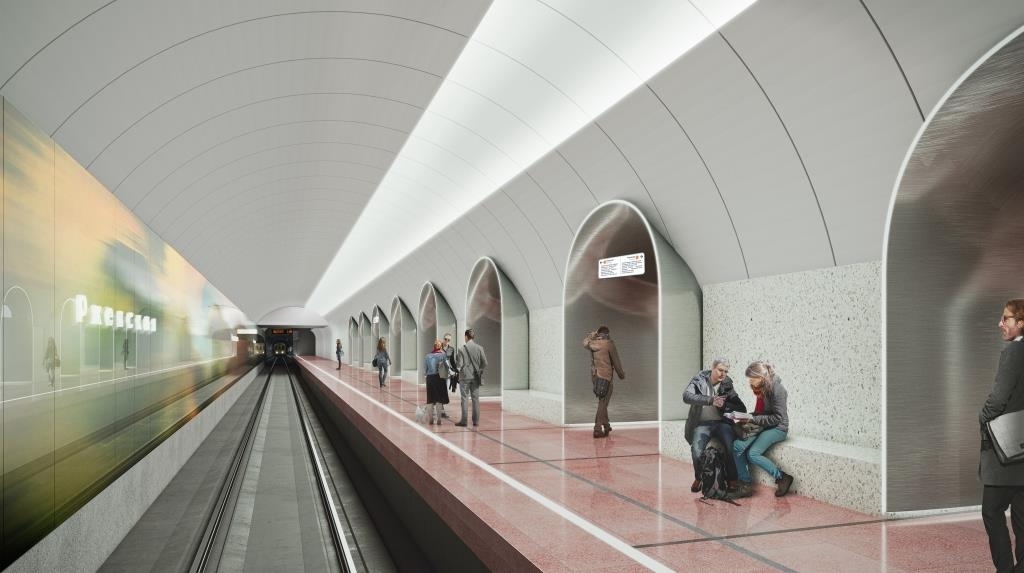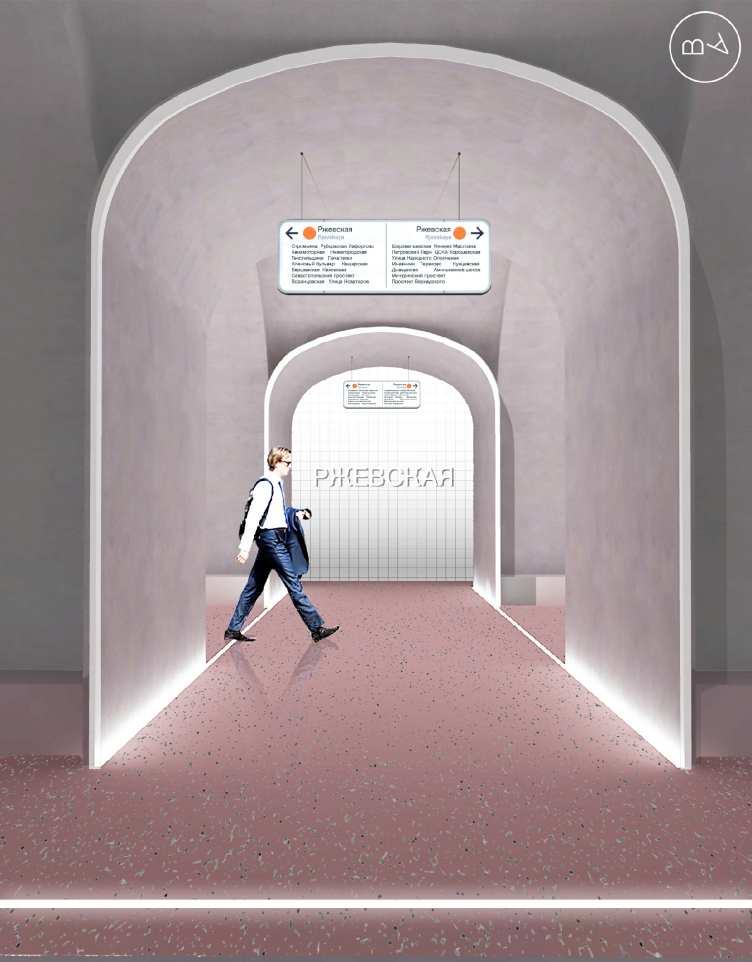“Rzhevskaya” metro station that got its name from the nearby railroad station, will soon open on the Rizhskaya Square, between the railway station and the “Rizhskaya” metro station, with which it will be connected by an underpass. This place is historical and symbolic in a certain sense: a long time ago, this place, also known as Krestovskaya Zastava, was one of Moscow’s city entrances. Now, instead of the Kamer-Kollezhsky Val, the square is traversed by the Third Transport Ring but the difference between its inner and outer sides is still clearly visible: on the one side, there is the old Moscow as we know it: Marina Roshcha, Sushchevsky Val, and Gilyarovskogo Street; on the other side, there are railroad tracks, industrial buildings, and the outbound highway of the Mira Avenue that eventually turns into the Yaroslavl Highway. Long gone are the red-brick water towers that stood here until the 1930’s, designed by the architect Maxim Geppner with an exquisite bridge between them, but even today the entrance to the “inner city” section of the Mira Avenue is framed by the towers of Stalin buildings on either side of the street. Thus, the “city gate” concept chosen by Blank Architects makes perfect sense both geographically and historically.
"Rzhevskaya" metro station © Blank Architects
"Rzhevskaya" metro station © Blank Architects
The material implementation of this concept took the form of one of the most ancient architectural archetypes, unique and perfect in its simplicity – an arch. Even The Arch: in reference to the project by Blank Architects, one indeed wants to write this word with a capital “A”. A welcoming symbol of entrance and invitation, this element is many times repeated in the interiors of the platforms and lobbies, gives a rhythmic feeling to the space and closes a lion’s share of the interior design. Its section view clearly shows that the architects chose for the arch a rather sophisticated curvilinear shape. “On the one hand, we wanted to make it tall and dramatic – explains one of the authors of the project, Tatyana Leontyeva – On the other hand, we had to make it all fit in with the existing construction elements: the height of the passage between the platforms cannot exceed 2.5 meters”. Because of this, the arches are turned to the platforms with their monumental portals – the higher one to the central, the lower one to the lateral platforms – and between them there is a smooth curve, the dramatic expressiveness of which the people can only appreciate from the outside where the same shape is encased in a glass box of the overland pavilion like a museum exhibit or a city sculpture which in fact it is.
"Rzhevskaya" metro station © Blank Architects
Designing things sixty meters underground, just like the very genre of transportation architecture, was something that Blank Architects handled for the first time. And this became a serious challenge and an interesting experience for them. “This is what we love competitions for – says the partner of the firm and one of the authors of the project Magda Kmita – They give you an opportunity to try your hand in entirely new architectural formats – we already designed hotels, schools, museums, and now we got our hands on a metro station”. The architects approached the task with all due seriousness – they read a lot of special literature, rode the Moscow metro and visited nearly its every station, and also did quite a bit of research on the world expertise. From the technology standpoint, the architects were able to master and come to grips with some things, some of the challenges – for example, the above-mentioned height restriction of the passage between the platforms – inspired unconventional solutions, and some were to remain bothersome limitations. For example, the authors of the project still lament the fact that, because of the operational complexities, they were unable to apply at least some minimal decoration to the walls and ceilings of the escalator groups, although in terms of a passenger’s average staying time this zone has a huge potential. As far as the general interior design is concerned, it was decided very early on to make it minimalist, without any unnecessary decorations. If we are to speak about some sources of inspiration in this case, Magda Kmita’s favorite station of Moscow metro is Kropotkinskaya – with its monumental “ancient Egypt” colonnade, while Tatyana Leontyeva add “Sokol” and “Airport” to her hit parade. “What these stations have in common is very simple design without any excessive and unnecessary decorative techniques but with a repetition and amplification of one single architectural element, beautifully backlit and setting the rhythm – she explains – And this was the effect that we looked to achieve in our project”.
"Rzhevskaya" metro station © Blank Architects
The main theme of the project is echoed by the intertwined motif of a travel that was inspired by the railway station standing on the square. As for the walls standing along the tracks, the architects plan to paint them with landscapes, but of a somewhat blurred quality – the way that they look from a window of a speeding train car. The traveling theme is supported by the lines on the lobby floors, reminding one of railroad tracks and also serving as a navigation instrument. A convenient navigation system is something that the Moscow metro still lacks – claim the authors of “Rzhevskaya”. In their project, they paid special attention to this issue, alongside the conventional things – such as LED screens, signs, and info points – a large role being given to intuitive navigation. For this reason, for example, the exits from the main platform are designed differently. The western one, through which one exits into the city, meaning, towards the railway station, is marked by a large wall-size interactive multimedia screen that shows the train schedule. As for the opposite exit, it all shines a yellow light – this is a transfer to the “Rizhskaya” metro station with its “amber” pylons (in addition, “Rizhskaya” is situated on the “orange” line of the Moscow metro).
"Rzhevskaya" metro station © Blank Architects
With all the program laconism of the decor, special role is given to the lighting design, including the functional aspect. Again, the architects place their bet on a person’s intuitive reactions: for example, the authors of the project propose to vary the intensity of light in the arches as the train enters the station. Thanks to this, a person, while still on the escalator, will understand that he had better hurry up – the way that we have already learn to get our bearings from the swelling sound of the oncoming train, only now it will be more reliable because it will be clear from which direction the train is approaching. And as for the passengers moving up the escalator, they will gradually find themselves in an ever-lighter environment: this technique will mark that we are moving outdoors, towards the light. In the underground lobbies, the direction of the passenger flows will be prompted by the turning angle of the arches, through which the passengers exit the station, in respect to the direction of movement of those who enter: thanks to this, the flows will be clearly separated.
"Rzhevskaya" metro station. Axonometric drawing © Blank Architects
Having a broad experience of designing shopping centers, Blank Architects know how to attract people to their projects and arouse their interest in order to make them stay longer. Of course, a metro station has a different purpose, not to say a diametrically opposite one – here what you need to do is optimize the traffic as much as you can. Nevertheless, the authors of the project did everything to make the few minutes that a person is going to spend at the “Rzhevskaya” metro station not only comfortable but emotionally satisfying. Examining the blurred landscapes behind the “arch” windows, tracing the junctions of the railroad lines on the floor, and following the change of the digits on the media screen, even the ever-busy morning passenger will be able to get distracted from his worries for a little while. According to Magda Kmita, it was important for the architect to create an environment where even a person that uses this station every day could always discover something new do that his metro ride would become a little trip for him.
"Rzhevskaya" metro station © Blank Architects
"Rzhevskaya" metro station © Blank Architects
The basis of the color set of the station is the exquisite combination of gray marble of the walls and stainless steel adorning the arches, with the warm shade of “rose ash” in the granite covering of the floor. According to the specifications, the decoration materials were to be of Russian origin. Initially, this presented a minor challenge but eventually the architects were able to use this condition to their advantage – they got acquainted with new companies and studied new possibilities of the stone in order to ultimately choose the sturdy and vandal-proof materials that are an absolute must in the conditions of the busy traffic of the metro station.
"Rzhevskaya" metro station © Blank Architects
The overland pavilion of the station which is situated on the territory of a small park squeezed between two automobile roads is inscribed in a small rectangle three by six meters. “We decided to make the walls completely transparent – explains Magda Kmita – We have so much different architecture around – the Rizhsky railway station, the rotunda of the “Rizhskaya” metro station, and the Stalin buildings on the Mira Avenue – hat we decided not to add another landmark. This is why we sort of “dissolved” the pavilion in space, only highlighting our arch”. The authors of the project would want to make the little park, currently all but unused, busier – in their project they propose a landscaping plan that provides for new benches, street lights, and greenery added along the park’s perimeter. Although it must be said that neither the technical specifications nor the budget of the future station provide for any improvement of the adjacent territory but Blank Architects always try to see the project as a whole, not limiting themselves to the dry specifications.
***
Recently it was announced that the project of “Rzhevskaya” metro station by Blank Architects, just as the project proposal for “Sheremetyevskaya”, made the shortlist or World Architecture Festival 2017 (for readers of Russian). We are still waiting for the results but what is more important is the fact that the implementation of the project is actually coming soon: if everything goes to plan, the first trains will pass through the “Rzhevskaya” metro station as early as in the beginning of 2020.
